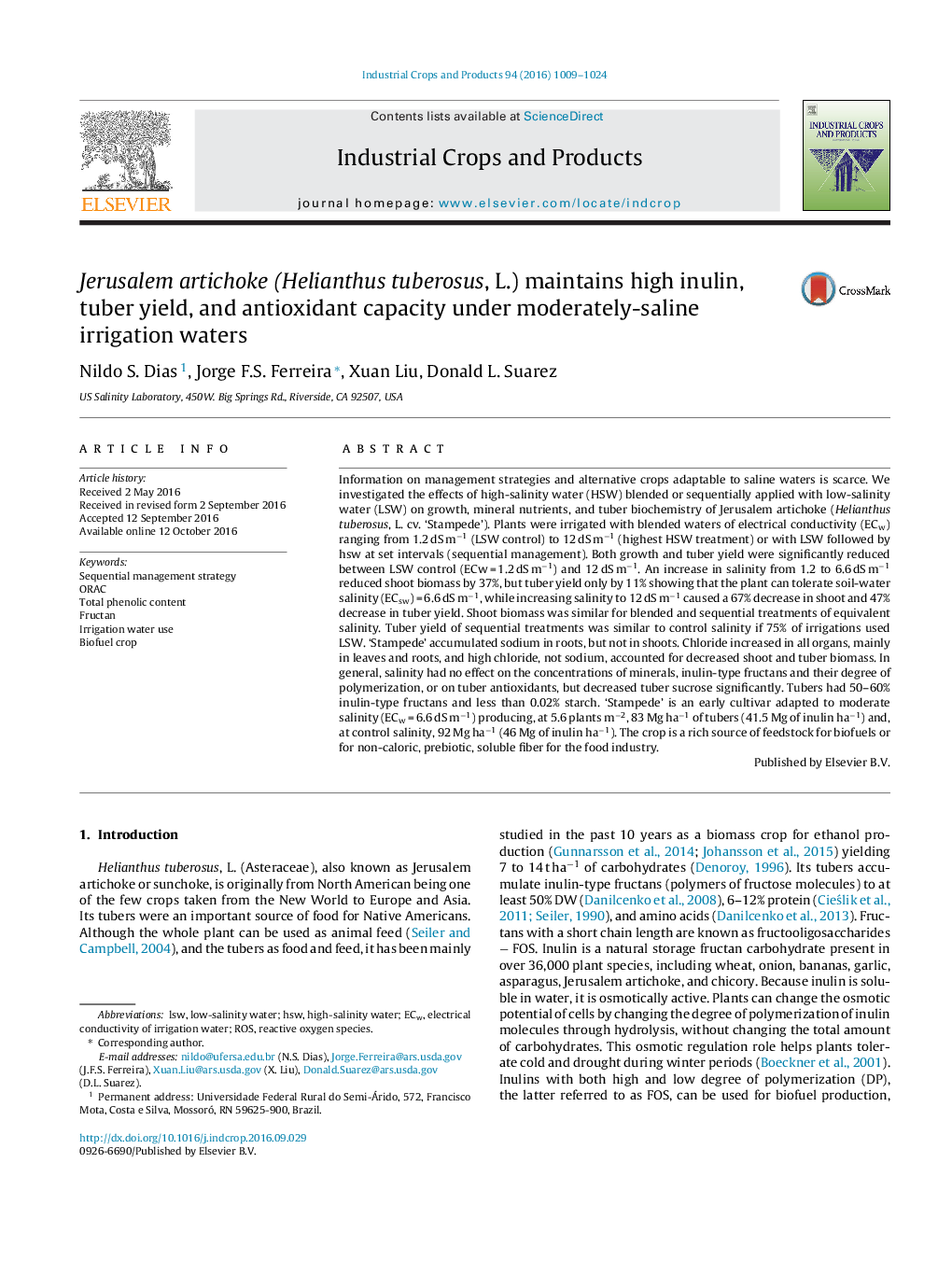| کد مقاله | کد نشریه | سال انتشار | مقاله انگلیسی | نسخه تمام متن |
|---|---|---|---|---|
| 6375527 | 1624816 | 2016 | 16 صفحه PDF | دانلود رایگان |
عنوان انگلیسی مقاله ISI
Jerusalem artichoke (Helianthus tuberosus, L.) maintains high inulin, tuber yield, and antioxidant capacity under moderately-saline irrigation waters
دانلود مقاله + سفارش ترجمه
دانلود مقاله ISI انگلیسی
رایگان برای ایرانیان
کلمات کلیدی
موضوعات مرتبط
علوم زیستی و بیوفناوری
علوم کشاورزی و بیولوژیک
علوم زراعت و اصلاح نباتات
پیش نمایش صفحه اول مقاله

چکیده انگلیسی
Information on management strategies and alternative crops adaptable to saline waters is scarce. We investigated the effects of high-salinity water (HSW) blended or sequentially applied with low-salinity water (LSW) on growth, mineral nutrients, and tuber biochemistry of Jerusalem artichoke (Helianthus tuberosus, L. cv. 'Stampede'). Plants were irrigated with blended waters of electrical conductivity (ECw) ranging from 1.2 dS mâ1 (LSW control) to 12 dS mâ1 (highest HSW treatment) or with LSW followed by hsw at set intervals (sequential management). Both growth and tuber yield were significantly reduced between LSW control (ECw = 1.2 dS mâ1) and 12 dS mâ1. An increase in salinity from 1.2 to 6.6 dS mâ1 reduced shoot biomass by 37%, but tuber yield only by 11% showing that the plant can tolerate soil-water salinity (ECsw) = 6.6 dS mâ1, while increasing salinity to 12 dS mâ1 caused a 67% decrease in shoot and 47% decrease in tuber yield. Shoot biomass was similar for blended and sequential treatments of equivalent salinity. Tuber yield of sequential treatments was similar to control salinity if 75% of irrigations used LSW. 'Stampede' accumulated sodium in roots, but not in shoots. Chloride increased in all organs, mainly in leaves and roots, and high chloride, not sodium, accounted for decreased shoot and tuber biomass. In general, salinity had no effect on the concentrations of minerals, inulin-type fructans and their degree of polymerization, or on tuber antioxidants, but decreased tuber sucrose significantly. Tubers had 50-60% inulin-type fructans and less than 0.02% starch. 'Stampede' is an early cultivar adapted to moderate salinity (ECw = 6.6 dS mâ1) producing, at 5.6 plants mâ2, 83 Mg haâ1 of tubers (41.5 Mg of inulin haâ1) and, at control salinity, 92 Mg haâ1 (46 Mg of inulin haâ1). The crop is a rich source of feedstock for biofuels or for non-caloric, prebiotic, soluble fiber for the food industry.
ناشر
Database: Elsevier - ScienceDirect (ساینس دایرکت)
Journal: Industrial Crops and Products - Volume 94, 30 December 2016, Pages 1009-1024
Journal: Industrial Crops and Products - Volume 94, 30 December 2016, Pages 1009-1024
نویسندگان
Nildo S. Dias, Jorge F.S. Ferreira, Xuan Liu, Donald L. Suarez,